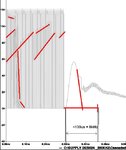T
treez
Guest

Disastrous problem intrinsic to DC restored transformer gate drives.
Hello,
The attached shows a disastrous problem with a DC restored transformer FET gate drive. (shown here with a cascaded buck SMPS)
…when the converter is suddenly no-loaded from full load, the duty cycle obviously goes fairly quickly to zero. Ater the duty cycle has finally gone to zero, the FET gate voltage of the high side FET lingers high for many switching periods…….BOOM!
As far as we can see, this can only be stopped by very heavy resistive damping…damping which is far too heavy for a transformer gate drive. So what’s the answer?
The attached shows the overall schematic, also a Ltspice simulation which demonstrates the problem, and the high side gate drive waveform which shows the FET gate-source voltage lingering high for far too long after D has gone to zero.
Hello,
The attached shows a disastrous problem with a DC restored transformer FET gate drive. (shown here with a cascaded buck SMPS)
…when the converter is suddenly no-loaded from full load, the duty cycle obviously goes fairly quickly to zero. Ater the duty cycle has finally gone to zero, the FET gate voltage of the high side FET lingers high for many switching periods…….BOOM!
As far as we can see, this can only be stopped by very heavy resistive damping…damping which is far too heavy for a transformer gate drive. So what’s the answer?
The attached shows the overall schematic, also a Ltspice simulation which demonstrates the problem, and the high side gate drive waveform which shows the FET gate-source voltage lingering high for far too long after D has gone to zero.




